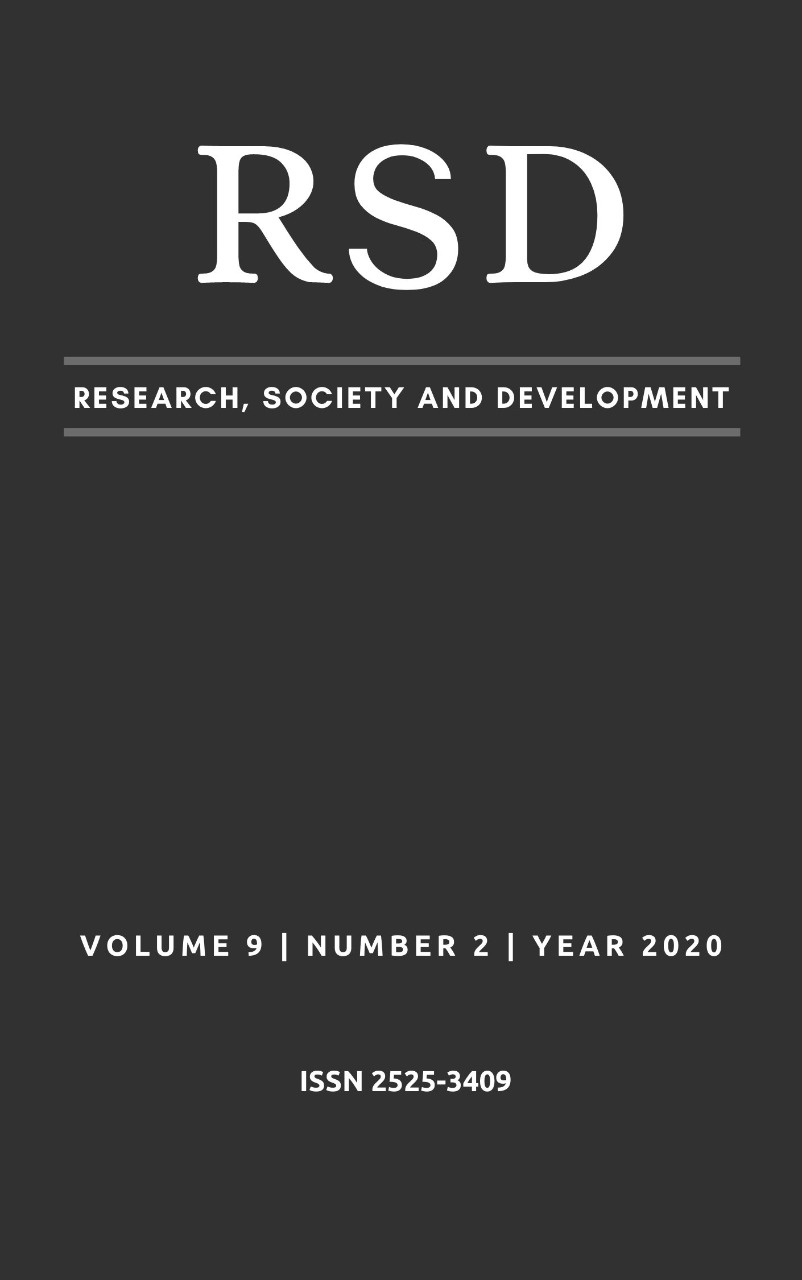Emissão de poeira em pátio de estocagem de minério de ferro: uma abordagem ambiental e ocupacional
DOI:
https://doi.org/10.33448/rsd-v9i1.1873Palavras-chave:
Poeira, Minério, Ferro, Ocupacional, Ambiental.Resumo
A mineração provoca inúmeros impactos ao meio ambiente, e a poluição do ar causada principalmente pela poeira resultante de seus processos é um dos fatores que mais causam doenças respiratórias ocupacionais entre os trabalhadores expostos. No Brasil, áreas importantes não são cobertas pelo monitoramento ambiental da qualidade do ar, estando com a iniciativa privada estas informações. Este é o caso do Estado do Maranhão, acerca do Distrito Industrial de São Luís – DISAL. Em 2018 foi publicado um artigo com dados de um monitoramento obtido por meio de uma Rede Automática de Monitoramento da Qualidade de Ar, de uma empresa privada instalada no DISAL, cujo resultado ultrapassava os limites impostos pela legislação ambiental vigente, diante destas informações, tornou-se nosso objeto principal, avaliar quantitativamente a emissão de Poeira Respirável Ocupacional nesta mesma área, adotando uma metodologia comparativa, observando os padrões da legislação trabalhista brasileira, pois ali, trabalham muitas pessoas expostas a estas condições, em um pátio de estocagem de minério de ferro de uma grande mineradora, para posteriormente estabelecer possíveis relações entre ambas, pois, apesar do resultado ambiental ter ultrapassado os limites de tolerância referenciados, o resultado da avaliação ocupacional, classificou está mesma área como apta ao trabalho. Concluimos então, que a legislação ambiental foi mais restritiva que a trabalhista e considerando apenas este estudo, podemos afirmar que no tocante a poluição atmosférica, para uma área ser classificada como SALUBRE ocupacionalmente, independe do resultado ambiental desta mesma área.
Referências
Abdollah, G.M. & Javad, F.N.S, (2012). Occupational Exposure Determination To Silica Dust In An Iron - Stone Ore And Comparison With Standard, 4(6): 1141-1149, https://www.ingentaconnect.com/content/doaj/18404529/00000004/0000
Arasteh, H. & Saeedi, G. (2016). Studying Hygienic Status of Mechanized Long Wall Face from the Perspective of the Existing Dust Containing Silica in Tabas Coal Mine. Geotechnical And Geological Engineering, [s.l.], 35(1): 213-224, 4 out. Springer Nature. http://dx.doi.org/10.1007/s10706-016-0099-2.
Elzinga, Evert J. et al. (2011). Iron speciation in urban dust. Atmospheric Environment. 45(2)26: 4528-4532, ISSN 1352-2310, https://doi.org/10.1016/j.atmosenv.2011.05.042.
Fundacentro (2009). Higiene Ocupacional, NHO 08: Coleta de Material particulado sólido suspenso no ar de ambientes de trabalho, Procedimento Técnico, São Paulo, 1ª Ed. Ministério do Trabalho e Emprego.
Furieri, B. et al. (2013). Aeolian erosion of storage piles yards: contribution of the surrounding areas. Environmental Fluid Mechanics, [s.l.], v. 14, n. 1, p.51-67, 19 jun. Springer Nature. http://dx.doi.org/10.1007/s10652-013-9293-4.
Goto, M. M. et al. (2018). A Qualidade Do Ar E Materiais Particulados Nos Portos Do Itaqui E Ponta Da Madeira – São Luís (MA). Revista de Ciência & Tecnologia, Piracicaba, v. 21, n. 41, p.103-116. Semestral. <http://dx.doi.org/10.15600/2238-1252/rct.v21n41p1-2
Huertas, J. I.; Huertas, M. E.; Solís, D. A. (2012). Characterization of airborne particles in an open pit mining region. Science of The Total Environment, Volume 423, Pages 39-46, ISSN 0048-9697, https://doi.org/10.1016/j.scitotenv.2012.01.065.
Janae, C.; Jason F.; Mark, P; Taylor, S. G.; Andrea, L.; Eric A, Betterton; A, Eduardo S. (2012). A review on the importance of metals and metalloids in atmospheric dust and aerosol from mining operations. Science of The Total Environment, Volume 433, Pages 58-73, ISSN 0048-9697, HYPERLINK "https://doi.org/10.1016/j.scitotenv.2012.06.013"itotenv.2012
Jon Roberts e Peter W. (2018). Research, Development and Application of Dust Suppression Technology. Proceedings of the 18th Coal Operators' Conference, Mining Engineering, University of Wollongong, February, Pages 319-328.
Ministério do meio ambiente. (2018). Conama. Resolução nº 003/1990. Retrieved Mar 10, 2018, from http://www.mma.gov.br/port/conama/res/res90/res0390.html.
Ministério do trabalho e emprego. (2009). MTE. Norma Regulamentadora. NR-15 - Atividades e Operações Insalubres. Retrieved nov 10, 2009, from http://www.trabalho.gov.br/seguranca-e-saude-no-trabalho/normatizacao/normas-regulamentadoras/norma-regulamentadora-n-15-atividades-e-operacoes-insalubres.
Noble, T. L. et al. (2016). Mineral Dust Emissions at Metalliferous Mine Sites, Environmental Indicators in Metal Mining. p. 281-306, Springer International Publishing, https://doi.org/10.1007/978-3-319-42731-7_16.
Tapia, J. S.; Valdés, J. O. R.; Tchernitchin, A.; Dorador, C., Bolados, A.; Harrod, C., (2018). Geologic and anthropogenic sources of contamination in settled dust of a historic mining port city in northern Chile: health risk implications. PeerJ 6:e4699 https://doi.org/10.7717/peerj.4699.
Cong, X. C., Yang, S. L., Cao, S.Q., Chen, Z. L., Dai, M. X., Peng., S. T., (2012). Effect of aggregate stockpile configuration and layout on dust emissions in an open yard. Applied Mathematical Modelling, Volume 36, Issue 11, Pages 5482-5491, ISSN 0307-904X, https://doi.org/10.1016/j.apm.2012.01.014.
Downloads
Publicado
Edição
Seção
Licença
Autores que publicam nesta revista concordam com os seguintes termos:
1) Autores mantém os direitos autorais e concedem à revista o direito de primeira publicação, com o trabalho simultaneamente licenciado sob a Licença Creative Commons Attribution que permite o compartilhamento do trabalho com reconhecimento da autoria e publicação inicial nesta revista.
2) Autores têm autorização para assumir contratos adicionais separadamente, para distribuição não-exclusiva da versão do trabalho publicada nesta revista (ex.: publicar em repositório institucional ou como capítulo de livro), com reconhecimento de autoria e publicação inicial nesta revista.
3) Autores têm permissão e são estimulados a publicar e distribuir seu trabalho online (ex.: em repositórios institucionais ou na sua página pessoal) a qualquer ponto antes ou durante o processo editorial, já que isso pode gerar alterações produtivas, bem como aumentar o impacto e a citação do trabalho publicado.


